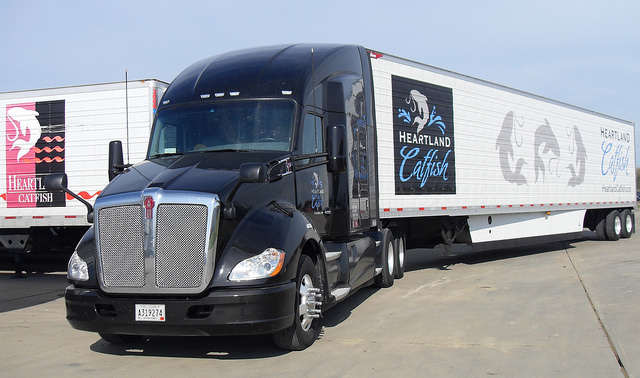Can truck specs improve rest and sleep?
Truck Drivers
Jun 4, 2015

— Sean Kilcarr
Here’s a thought: can you spec your way to better rest and sleep on the road? It’s a question both fleets and independents alike might ask themselves.
Of course, one reason I’m asking it in this space is that I recently wrapped up an article addressing efforts to improve the quality of rest and sleep for drivers on the road.
 And as part of my research for that story, I talked with James Sorrels (on the right in this photo, with Dennis Jones on the left) to get some insight into how truck specs can play a big role in helping drivers get better rest and sleep after rolling down the asphalt all day (or all night, depending on their schedule.)
Sorrels will tell you he spent several decades behind the wheel of a big rig, pounding out long miles and then sometimes sleeping lengthwise across the driver and passenger seats in his daycab tractor.
Thus when he became director of transportation of the private fleet operation at Heartland Catfish in Itta Bena, MS, over a decade ago, he intimately understood the critical role truck specifications play in helping commercial drivers obtain good rest and sleep.
“We’re not a fleet that sits around a lot; we’re loading and unloading and doing quick turnarounds,” he explained to me. “So we wanted to reduce the daily ‘wear and tear’ on our drivers from physically operating the truck as well as providing them with a sleeper where they can get the best rest possible.”
That’s why, when Heartland purchased new Kenworth T680s (seen below) for its 22 tractor fleet, two key specs included automated manual transmissions (AMTs) and the “Diamond VIT” premium package for its 76-inch and 52-inch sleepers.
Sorrels made that determination in part after clocking in a 1,336 mile test drive with one of Heartland’s veteran drivers,Dennis “Pops” Jones.
“At first we both had problems, because we both wanted to shift – but there’s no [traditional] shifter or clutch pedal with an AMT,” Sorrels told me. “But we both felt so rested after that run after making that one trip I was totally sold. Also, it allows the driver to keep both hands on the wheel 100% of the time and we got really good fuel economy, too.”
The “Diamond VIT” package Heartland spec’d for its sleepers includes a refrigerator, TV package, rotating table, and microwave.
“That cab is a driver’s office and home away from home; they need to be able to climb in there and easily relax,” he says. “That is what helps them feel rested for the next haul.”
Lance Platt, CEO for in-cab satellite TV system provider EpicVue, stressed a similar view of such “relaxation” needs for drivers in an email to me, though he emphasized it is very important to differentiate rest from sleep.
And as part of my research for that story, I talked with James Sorrels (on the right in this photo, with Dennis Jones on the left) to get some insight into how truck specs can play a big role in helping drivers get better rest and sleep after rolling down the asphalt all day (or all night, depending on their schedule.)
Sorrels will tell you he spent several decades behind the wheel of a big rig, pounding out long miles and then sometimes sleeping lengthwise across the driver and passenger seats in his daycab tractor.
Thus when he became director of transportation of the private fleet operation at Heartland Catfish in Itta Bena, MS, over a decade ago, he intimately understood the critical role truck specifications play in helping commercial drivers obtain good rest and sleep.
“We’re not a fleet that sits around a lot; we’re loading and unloading and doing quick turnarounds,” he explained to me. “So we wanted to reduce the daily ‘wear and tear’ on our drivers from physically operating the truck as well as providing them with a sleeper where they can get the best rest possible.”
That’s why, when Heartland purchased new Kenworth T680s (seen below) for its 22 tractor fleet, two key specs included automated manual transmissions (AMTs) and the “Diamond VIT” premium package for its 76-inch and 52-inch sleepers.
Sorrels made that determination in part after clocking in a 1,336 mile test drive with one of Heartland’s veteran drivers,Dennis “Pops” Jones.
“At first we both had problems, because we both wanted to shift – but there’s no [traditional] shifter or clutch pedal with an AMT,” Sorrels told me. “But we both felt so rested after that run after making that one trip I was totally sold. Also, it allows the driver to keep both hands on the wheel 100% of the time and we got really good fuel economy, too.”
The “Diamond VIT” package Heartland spec’d for its sleepers includes a refrigerator, TV package, rotating table, and microwave.
“That cab is a driver’s office and home away from home; they need to be able to climb in there and easily relax,” he says. “That is what helps them feel rested for the next haul.”
Lance Platt, CEO for in-cab satellite TV system provider EpicVue, stressed a similar view of such “relaxation” needs for drivers in an email to me, though he emphasized it is very important to differentiate rest from sleep.
 “In my estimation, television plays an important role in a driver’s ability to get the rest they need in a couple of ways,” he explained. “First, driver experience shows that the ability to watch television during [freight] drop-off and pick-up periods helps them reduce stress levels. Second, drivers are reporting that their ability to watch television at the end of a long day helps them to wind down in preparation for a good night sleep.”
In either case, Platt told me that drivers are using television as a way to help obtain the rest and relaxation they need while on the road.
“I understand it may be argued that television viewing could negatively impact a driver’s sleep,” Platt pointed out. “To that I note that we install a DVR [digital video recorder] for this very reason. The driver is able to record his or her shows while they are sleeping that they can watch at a later time.”
Holland Enterprises, Inc. – a Fargo, ND-based refrigerated carrier operating 220 tractors – recently installed 175 EpicVue satellite TV systems in its trucks for some of those very reasons.
“As a 48-state, long haul trucking company with an average length of haul of 1,550 miles, we need … drivers who are willing to be on the road 14 to 21 days at a time,” said Brad Schemel, Holland’s VP. “Satellite TV gives them the option of sitting in the comfort of their truck and doing things there that they may otherwise do inside a truck stop. It gives them the flexibility of watching what they want, when they want. It’s a definite creature comfort for drivers and provides a greater level of satisfaction with the job.”
Something to think about when the time to consider buying a new or used truck for your business comes around again.
Original source: http://news.trucker.com/blog/can-truck-specs-improve-rest-and-sleep
“In my estimation, television plays an important role in a driver’s ability to get the rest they need in a couple of ways,” he explained. “First, driver experience shows that the ability to watch television during [freight] drop-off and pick-up periods helps them reduce stress levels. Second, drivers are reporting that their ability to watch television at the end of a long day helps them to wind down in preparation for a good night sleep.”
In either case, Platt told me that drivers are using television as a way to help obtain the rest and relaxation they need while on the road.
“I understand it may be argued that television viewing could negatively impact a driver’s sleep,” Platt pointed out. “To that I note that we install a DVR [digital video recorder] for this very reason. The driver is able to record his or her shows while they are sleeping that they can watch at a later time.”
Holland Enterprises, Inc. – a Fargo, ND-based refrigerated carrier operating 220 tractors – recently installed 175 EpicVue satellite TV systems in its trucks for some of those very reasons.
“As a 48-state, long haul trucking company with an average length of haul of 1,550 miles, we need … drivers who are willing to be on the road 14 to 21 days at a time,” said Brad Schemel, Holland’s VP. “Satellite TV gives them the option of sitting in the comfort of their truck and doing things there that they may otherwise do inside a truck stop. It gives them the flexibility of watching what they want, when they want. It’s a definite creature comfort for drivers and provides a greater level of satisfaction with the job.”
Something to think about when the time to consider buying a new or used truck for your business comes around again.
Original source: http://news.trucker.com/blog/can-truck-specs-improve-rest-and-sleep




